[javascript protected email address]
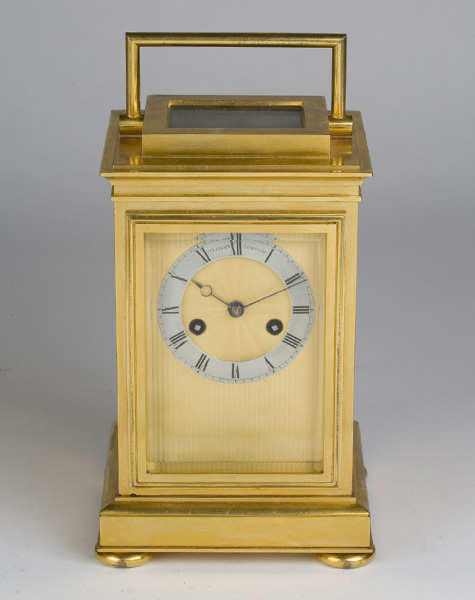
Benjamin Lewis Vulliamy, London No.1239

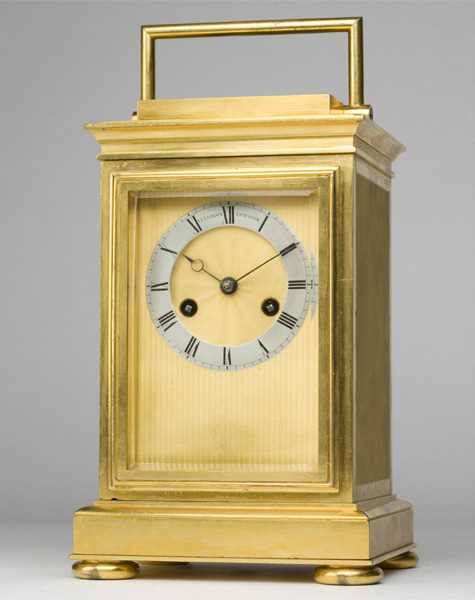
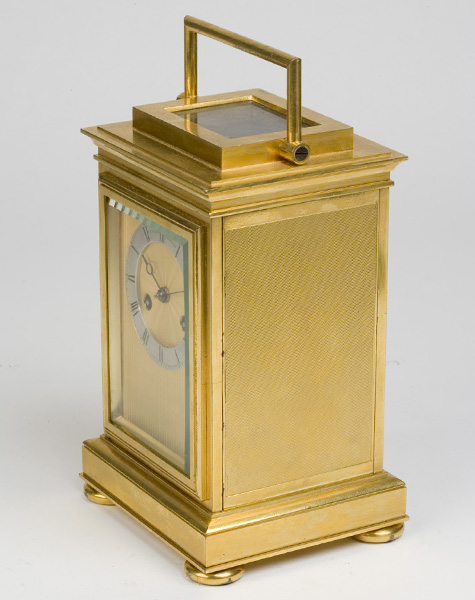
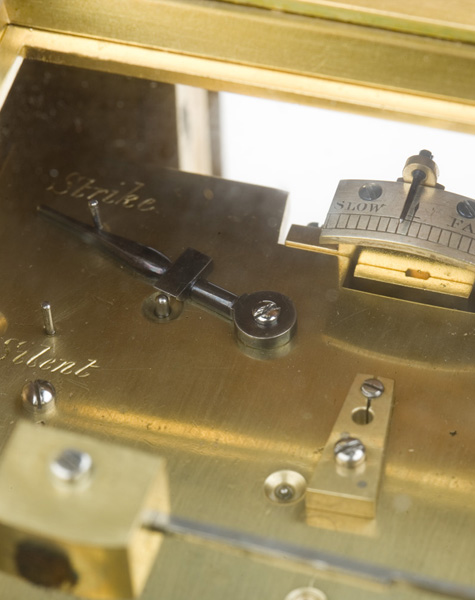
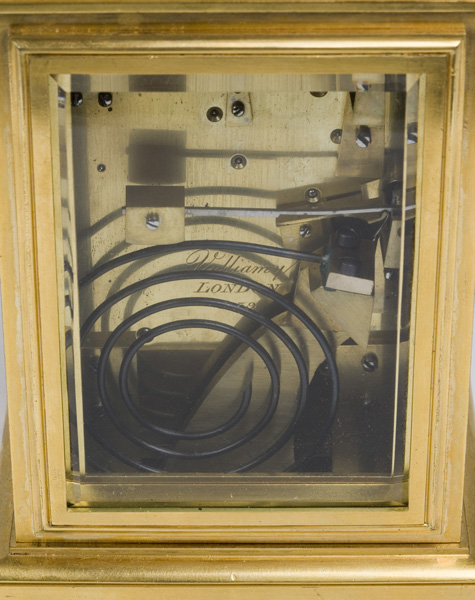
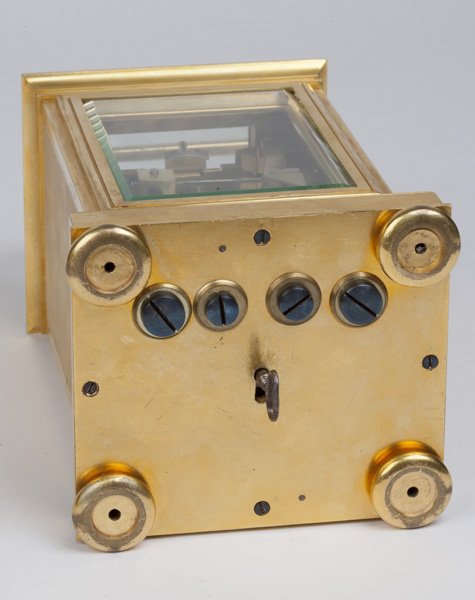
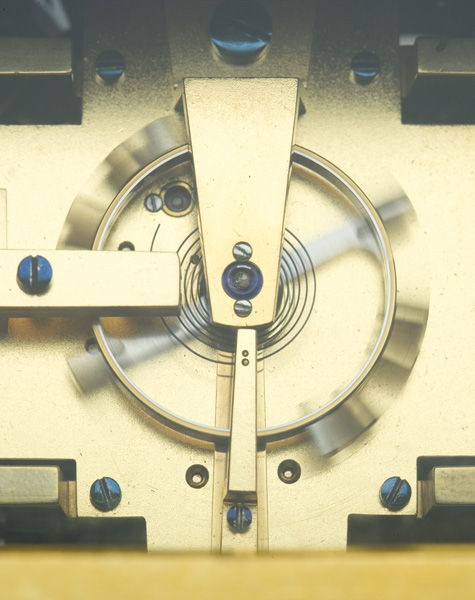
Circa 1836
Sold
7½ inches high
A rare gilt-brass striking travelling clock with lever escapement. The Case The fire-gilded brass case with moulded front and rear doors employing a unique release system using a steel door key in the centre of the baseplate, the sides of the case have integral engine turned gilt panels. The top with a large raised rectangular viewing portal and typical Vulliamy molded rectangular articulated carrying handle, the base on gilt-brass bun feet. The Dial The rectangular herringbone engraved gilt brass mask with typical narrow silvered Roman chapter ring signed Vulliamy, London around XII. The dial centre engine-turned with twin winding holes. The original blued hands are well pierced and shaped. MOVEMENT The Movement The movement with five pillars and twin chain fusees, Harrison’s maintaining power, large gilt platform with underslung lever escapement with large diameter cut bimetallic compensated balance and flat blued hairspring with diamond endstone, hour strike on a blued steel gong and the backplate engraved Vulliam, London. 1239. A blued steel lever is mounted top left on the backplate and engraved for Strike and Silent. Bibliography: Carriage & other travelling clocks, Derek Roberts. Schiffer 1993. Illustrated p.261. Comments This is an exceptional travelling clock and quite possibly unique, it is likely to have been made for someone who travelled a great deal and required a clock to put up with rough handling. The unusual double-lock door release system indicates a need for security and the most likely candidates for ownership are military. With Vulliamy’s reputation and this unique locking system the original owner is likely to be someone of considerable seniority. The clock retains its original gilding that is worn in areas that one would expect. B.L.Vulliamy made approximately 13 travelling clocks, of these, only 2 are known with metal cases, the remainder being wooden. The movement is finished to Vulliamy’s highest standard with an unusual three vane fly for the strike and counter-balanced star wheel jumper. THE VULLIAMY FAMILY 1730 - 1854. Justin Vulliamy Francois Justin Vulliamy was born in Switzerland and emigrated to England in circa 1730. He was a man of great ability and in 1743 went into partnership with his future father-in-law Benjamin Gray of Pall Mall (c.1720-64), whose daughter he married in 1746. Gray was by that time Clockmaker to George II, having been granted the Royal Warrant in 1742. They produced clocks and watches of outstanding quality. From around 1780 the clocks started to be numbered*. There are many fine examples of their work including a watch dated 1757 in the Guildhall Museum (once owned by James Stockham, commander of the 'Thunderer' at the battle of Trafalgar). Two long case clocks in the Wetherfield Collection (Dispersed 1928), and repeating watches are also documented in the Ilbert and the Dennison collections. Benjamin Gray died in 1764 and the Royal Warrant passed to Justin Vulliamy remaining with his family for three generations until 1854. Justin Vulliamy died circa 1790. Benjamin Vulliamy The son of Justin, Benjamin Vulliamy was free of the Clockmakers Company in 1781 and continued the business, with Royal patronage, from Pall Mall. The author F.J.Britten states that he was 'much favoured and consulted by George III on mechanical subjects especially in connection with Kew observatory, which was a hobby of the King'. There were numerous clocks supplied to the Royal family, including in 1785, a very fine regulator for the King. Benjamin Vulliamy died in 1820. Benjamin Lewis Vulliamy Born in 1780, the son of Benjamin, Benjamin Lewis Vulliamy was free of the Clockmakers Company in 1809 and went into business with his father, continuing to trade from Pall Mall. He was clockmaker to George IV, William IV and Victoria. Benjamin Lewis Vulliamy died in 1854. He supplied many clocks to government offices as well as the Royal palaces. *Although the numbering of Vulliamy clocks started many years before, the first surviving record book begins with clock No. 296 delivered in 1797. They are extremely rare and important documents showing details of the makers of cases & movements, date of manufacture, as well as prices. The Vulliamys maintained good relations with favoured suppliers over a long period, with particular types of clock usually made by the same supplier. For example: '…the best eight day spring clock with quarter chimes' (bracket clock). Jackson of Chapel Row, Spa Fields made many of these movements, while most of the cases were by Rich of Lincoln's Inn Fields. The price of these clocks in 1815 was 36 guineas.
